28-Letter Templates: Fostering Student Behaviors in the Classroom
Welcome to our collection of “Letter to Parents about Student’s Behavior in Classroom” templates! We’re excited to have you here and provide you with a valuable resource for effective communication. Our goal is to support you in maintaining a strong connection between home and school, so we can work together in the best interest of your child. These templates have been carefully crafted to help you address various aspects of your child’s behavior in a thoughtful and meaningful way. We understand that each situation is unique, and these templates are designed to assist you in expressing your concerns, celebrating achievements, and seeking your collaboration. Our aim is to foster open and positive lines of communication that contribute to your child’s success and well-being. We hope you find these templates helpful in navigating the sometimes challenging but always important conversations about your child’s behavior.
Guidance And Tips
- Encourage open communication: Emphasize the importance of regular communication between parents and teachers to stay updated on the student’s progress and address any concerns promptly.
- Establish consistent expectations: Share the behavioral expectations set in the classroom and encourage parents to reinforce them at home, promoting consistency in behavior management.
- Create a structured routine: Suggest the implementation of a structured routine at home that includes designated study time, consistent bedtime, and regular meal times to promote a sense of stability and responsibility.
- Encourage positive reinforcement: Highlight the significance of praising and rewarding the student for their positive behaviors, both at home and in the classroom, to reinforce desired actions.
- Teach problem-solving skills: Provide guidance on teaching the student problem-solving techniques, such as active listening, conflict resolution, and identifying appropriate responses in challenging situations.
- Limit distractions: Advice parents to create a distraction-free environment at home, such as minimizing screen time, to promote focus and concentration during study and homework time.
- Foster a growth mindset: Encourage parents to help the student develop a growth mindset by emphasizing the value of effort, perseverance, and learning from mistakes, rather than solely focusing on outcomes or grades.
- Seek additional support if needed: Offer information about available resources or counseling services within the school or community that can provide further assistance if the behavioral challenges persist.
#1: Introduction Letter:
A general letter introducing yourself as the teacher and outlining your expectations for student behavior in the classroom.
The introduction letter serves as an important communication tool between the teacher and the parents. Its purpose is to establish a positive and professional relationship from the outset of the school year. The letter introduces the teacher to the parents, providing them with essential information about the teacher’s background, experience, and teaching philosophy. It also serves as an opportunity for the teacher to outline their expectations for student behavior in the classroom, setting clear guidelines and standards for a conducive learning environment. The letter helps parents understand the teacher’s approach to discipline, classroom management, and the importance of cooperation between home and school. By sharing this information upfront, the introduction letter aims to foster open lines of communication, collaboration, and mutual understanding between the teacher, parents, and students.
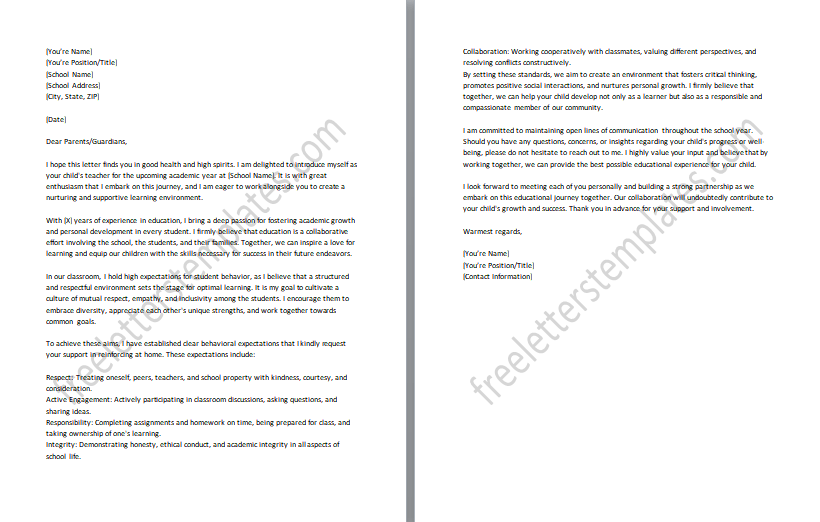
#2: Positive Behavior Recognition:
A letter praising a student for their positive behavior and highlighting their achievements in the classroom.
The positive behavior recognition letter is a heartfelt way to celebrate and uplift a student for their outstanding behavior and achievements in the classroom. It’s a special opportunity for us to shine a light on the positive actions they’ve taken, like being kind to others, showing respect, putting in extra effort, or achieving remarkable academic success. By specifically mentioning moments or examples of their exceptional behavior, we want to make sure they know just how much we appreciate and value their actions. This letter isn’t just about boosting their confidence and motivation—it also lets parents know that we recognize and cherish their child’s efforts and positive impact in our classroom. Plus, it inspires other students to follow suit, creating an environment where respect, kindness, and excellence thrive.
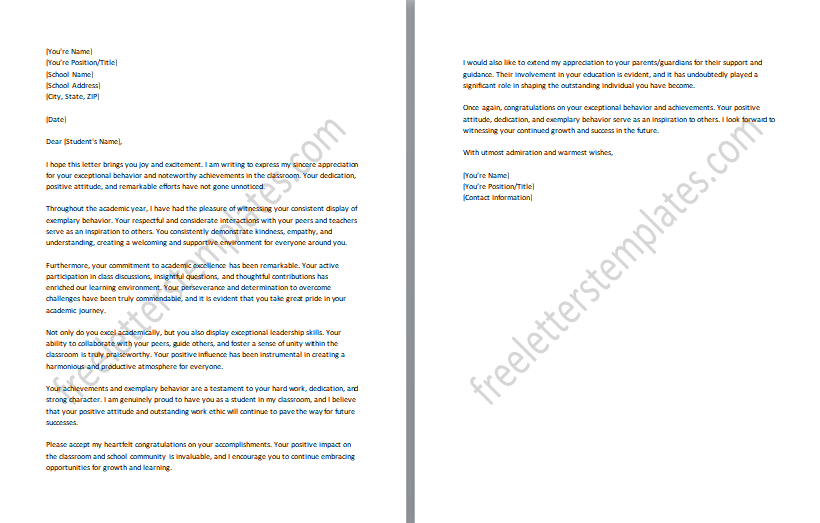
#3: Academic Progress Concerns:
A letter addressing concerns about a student’s behavior that is negatively impacting their academic progress.
When it comes to addressing concerns about a student’s behavior impacting their academic progress, the academic progress concerns letter plays a crucial role. Its purpose is to communicate with parents or guardians about observed behavior patterns that are hindering the student’s academic growth. In this letter, the teacher expresses their genuine concern and outlines specific instances or trends that have been noticed, which may include lack of focus, incomplete assignments, difficulty following instructions, or disruptive behavior in class. The letter aims to initiate a collaborative effort between the teacher and parents to address these concerns and find potential solutions. By sharing these concerns, the letter seeks to foster open communication, invite parental involvement, and ultimately support the student in overcoming their challenges to achieve academic success.
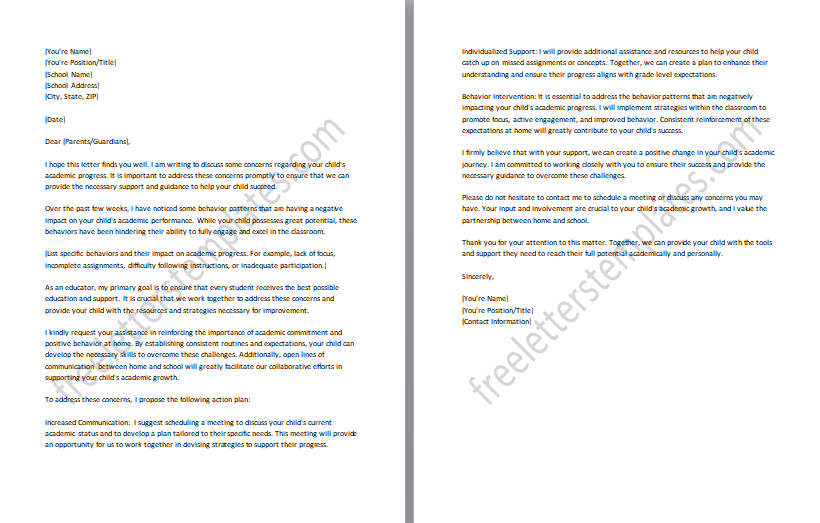
#4: Attendance Issues:
A letter discussing a student’s consistent tardiness or absenteeism and its impact on their learning.
When it comes to addressing attendance issues, a letter can be a valuable tool for communicating concerns and highlighting the impact of consistent tardiness or absenteeism on a student’s learning. The purpose of this letter is to inform parents or guardians about their child’s attendance patterns and the potential consequences it may have on their academic progress. In the letter, the teacher expresses genuine concern and provides specific details regarding the student’s attendance record, including the number of absences or instances of tardiness. The letter emphasizes the importance of consistent attendance and how it directly affects the student’s ability to fully participate in classroom activities, engage in discussions, and receive important instruction. Furthermore, the letter may provide information about school policies regarding attendance and potential interventions or supports that can be put in place to help the student improve their attendance. By sharing this information, the letter aims to promote parental awareness and collaboration, encouraging them to work together with the school to address and rectify the attendance issues, ultimately supporting the student’s academic success and overall well-being.
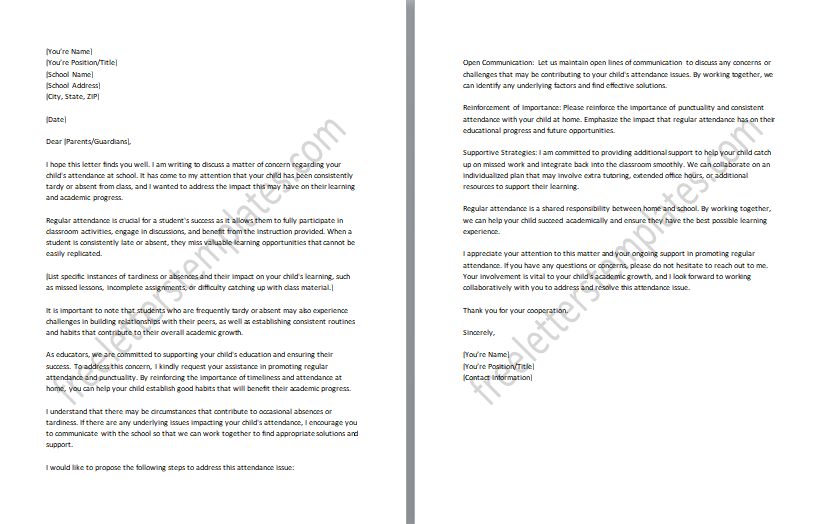
#5: Disruptive Behavior:
A letter addressing disruptive behavior exhibited by a student and discussing the consequences if the behavior continues.
Addressing disruptive behavior exhibited by a student requires a compassionate and empathetic approach. When writing a letter, it’s important to use a human-like tone to convey the concerns and discuss potential consequences. The goal is to engage parents or guardians in a constructive dialogue and encourage their support in addressing the issue. By using relatable language and expressing genuine care, the letter can effectively convey the impact of disruptive behavior and emphasize the need for positive change.
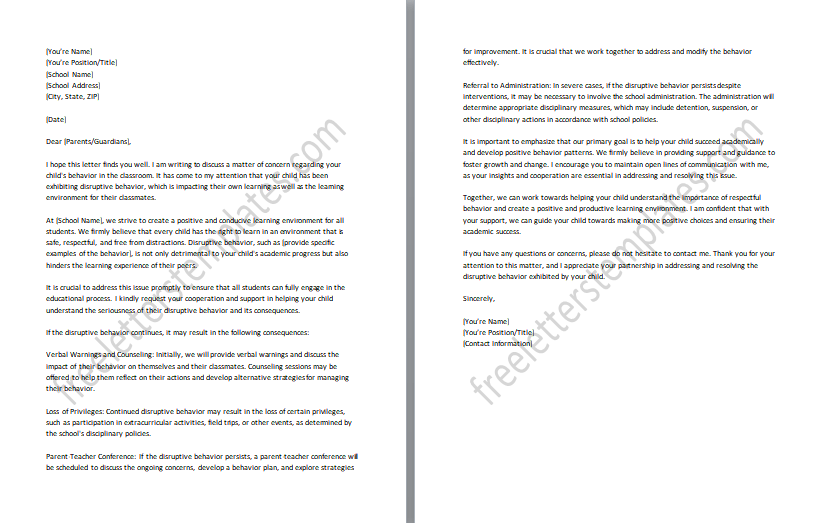
#6: Bullying or Harassment:
A letter notifying parents about incidents of bullying or harassment involving their child and explaining the steps being taken to address the issue.
Addressing incidents of bullying or harassment requires a sensitive and compassionate approach when writing a letter to parents. It’s crucial to convey the seriousness of the issue while expressing empathy and concern. The explanatory paragraph should explain the situation clearly, notifying parents about the incidents involving their child. It should also outline the steps being taken by the school to address the issue, such as investigations, counseling, and disciplinary measures. By providing this information, the letter aims to reassure parents that the school takes bullying or harassment seriously and is committed to creating a safe and inclusive environment for all students.
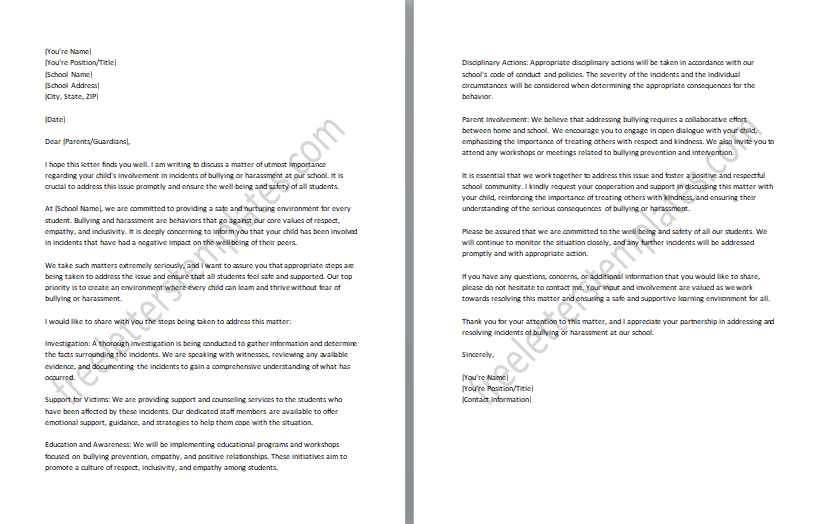
#7: Lack of Participation:
A letter expressing concerns about a student’s lack of participation in class activities and discussions.
Addressing a student’s lack of participation in class activities and discussions requires a compassionate and understanding tone. When writing a letter, it’s important to express concern while acknowledging the unique qualities and potential of the student. The goal is to engage parents or guardians in a collaborative conversation and seek their support in encouraging the student to become more involved. By using a human-like tone, the letter can effectively convey the importance of active participation and the positive impact it can have on the student’s learning experience.
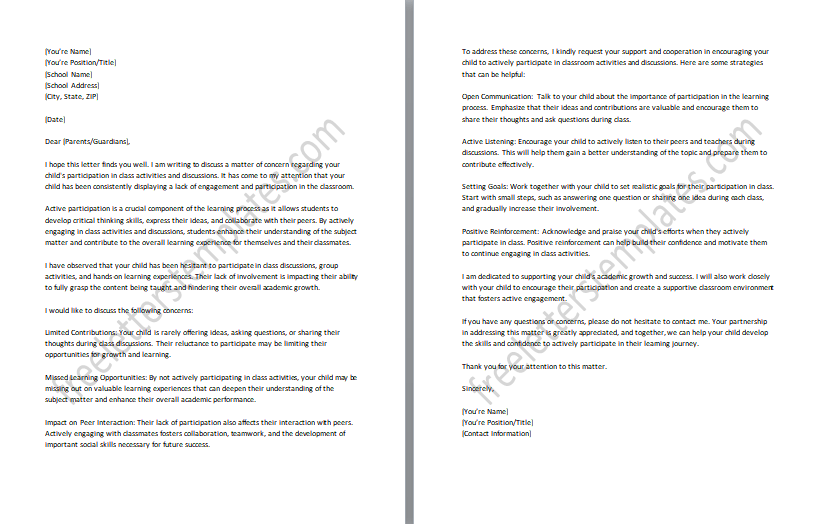
#8: Homework Completion:
A letter discussing a student’s consistent failure to complete homework assignments and its impact on their academic performance.
When addressing a student’s consistent failure to complete homework assignments, it is crucial to approach the issue with understanding and support. Writing a letter in a human-like tone allows you to express concern for the student’s academic progress while emphasizing the importance of completing homework. The explanatory paragraph should communicate the impact that incomplete homework assignments can have on the student’s overall academic performance. It should highlight the correlation between homework completion and reinforcing classroom learning, as well as the skills and responsibility developed through independent practice. By conveying this information in a compassionate manner, the letter aims to encourage parents or guardians to collaborate with the school in establishing a consistent homework routine and providing necessary support to ensure the student’s success.
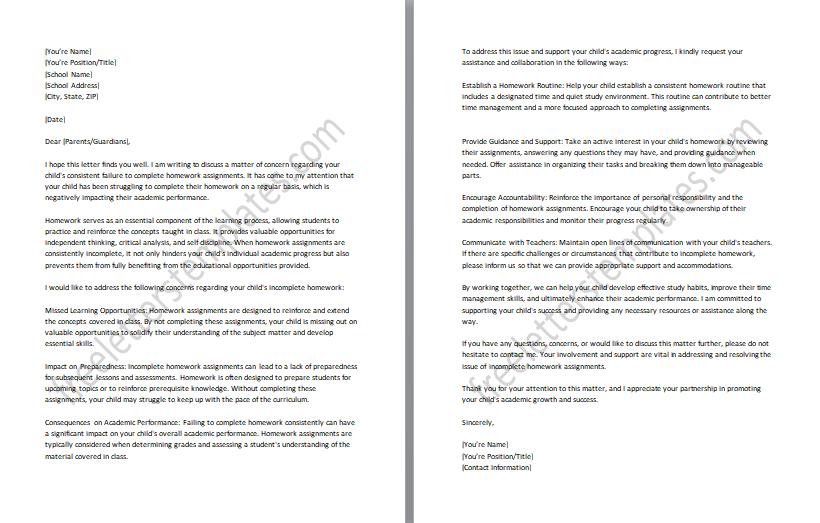
#9: Lack of Organization:
A letter highlighting a student’s struggle with staying organized and providing suggestions for improvement. Addressing a student’s lack of organization requires a compassionate and understanding tone. When writing a letter, it’s important to express concern while acknowledging the challenges the student may be facing. The goal is to engage parents or guardians in a collaborative conversation and provide suggestions for improvement. By using a human-like tone, the letter can effectively communicate the importance of organizational skills and offer practical strategies or resources to support the student in developing better organizational habits.
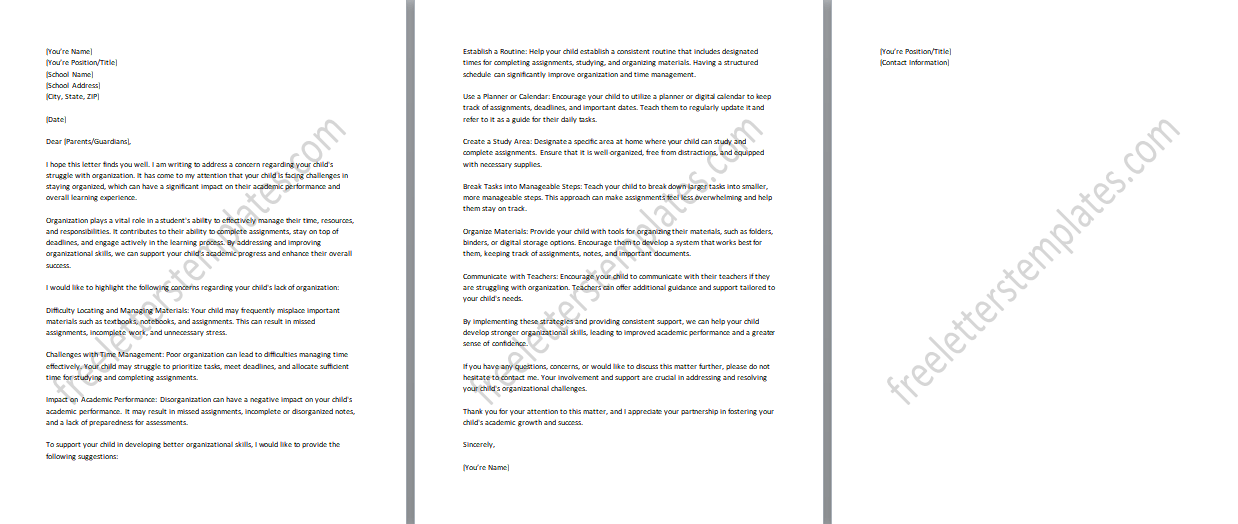
#10: Respect and Kindness:
A letter emphasizing the importance of respect and kindness in the classroom and addressing any incidents where a student’s behavior has fallen short. Addressing the importance of respect and kindness in the classroom requires a compassionate and understanding tone. When writing a letter, it’s important to express the significance of these values while acknowledging any instances where a student’s behavior may not have met the expected standards. The goal is to engage parents or guardians in a collaborative conversation and emphasize the need for respectful and kind behavior. By using a human-like tone, the letter can effectively convey the importance of these values in creating a positive and inclusive classroom environment, while also encouraging the student to reflect on their actions and make positive changes.
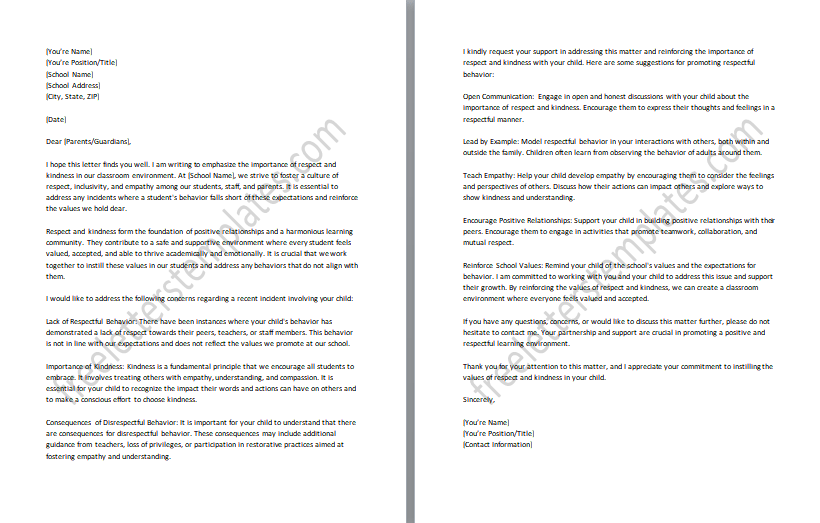
#11: Listening and Following Instructions:
A letter discussing a student’s difficulty in listening and following instructions during class.
Addressing a student’s difficulty in listening and following instructions requires a compassionate and understanding tone. When writing a letter, it’s important to express concern while acknowledging the challenges the student may be facing. The goal is to engage parents or guardians in a collaborative conversation and offer support and strategies for improvement. By using a human-like tone, the letter can effectively communicate the importance of these skills and highlight the impact they have on the student’s learning experience.
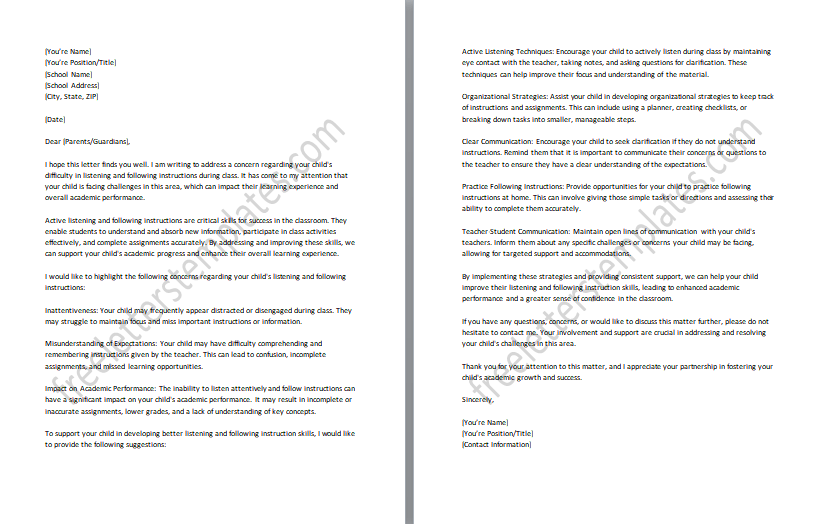
#12: Time Management Issues:
A letter addressing a student’s challenges with managing their time effectively and its impact on their academic performance.
Addressing a student’s time management issues requires a supportive and understanding approach. When writing a letter, it’s important to express concern while acknowledging the challenges the student may be facing in managing their time effectively. The goal is to engage parents or guardians in a collaborative conversation and provide suggestions and resources to help the student improve their time management skills. By using a human-like tone, the letter can effectively communicate the importance of effective time management and how it impacts the student’s academic performance.
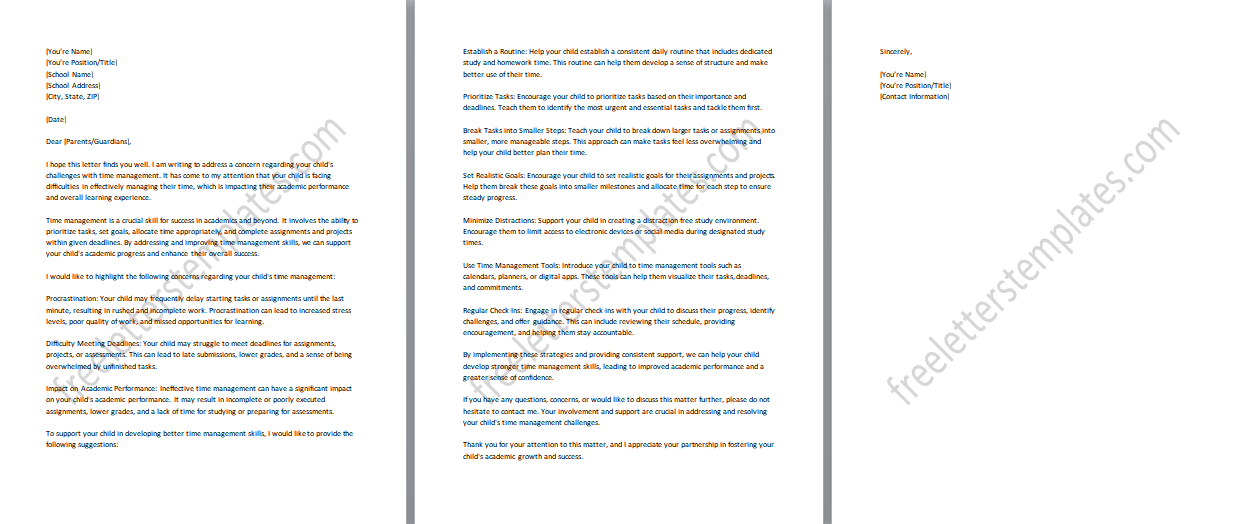
#13: Talking or Interrupting:
A letter discussing a student’s habit of talking excessively or interrupting during class and its effect on the learning environment.
Addressing a student’s habit of talking excessively or interrupting during class requires a compassionate and understanding tone. When writing a letter, it’s important to express concern while acknowledging the impact this behavior may have on the learning environment. The goal is to engage parents or guardians in a collaborative conversation and seek their support in addressing the issue. By using a human-like tone, the letter can effectively communicate the importance of active listening and respectful communication, and how it contributes to a positive and productive classroom environment.
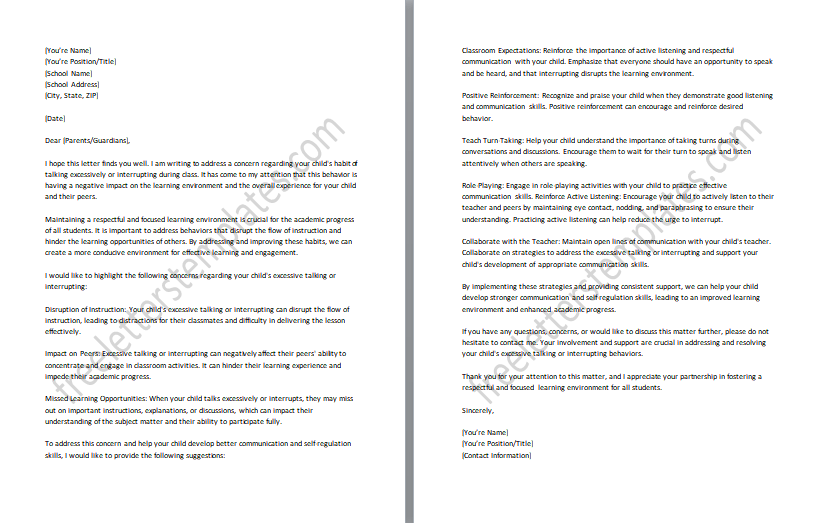
#14: Inappropriate Language:
A letter addressing the use of inappropriate language by a student and reinforcing the need for respectful communication.
Addressing the use of inappropriate language by a student requires a firm yet compassionate approach. When writing a letter, it’s important to express concern about the use of such language while emphasizing the importance of respectful communication. The goal is to engage parents or guardians in a collaborative conversation and reinforce the expectation of using appropriate language in both the classroom and everyday interactions. By using a human-like tone, the letter can effectively communicate the impact of inappropriate language on the learning environment and encourage parents or guardians to work together with the school in promoting respectful communication skills and positive behavior.
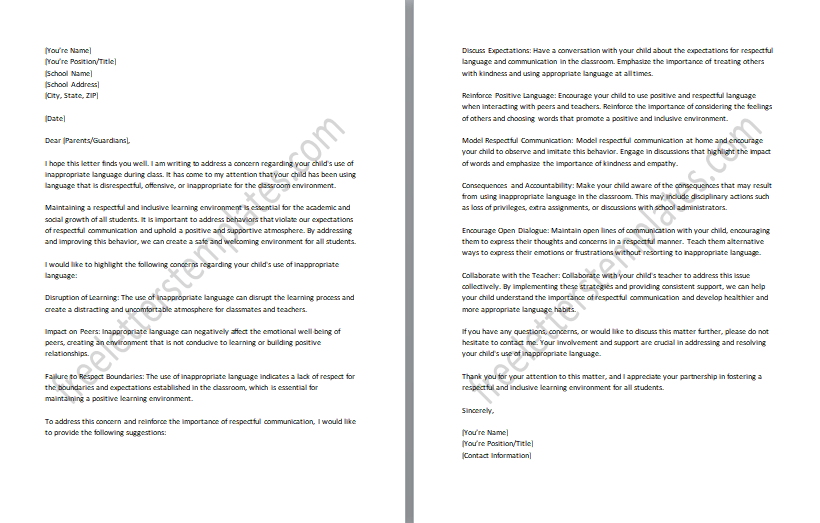
#15: Use of Electronic Devices:
A letter reminding parents and students about the school’s policy on the use of electronic devices in the classroom.
Addressing the use of electronic devices in the classroom requires a clear and informative tone. When writing a letter, it’s important to remind parents and students about the school’s policy on electronic devices and provide an explanation for the rationale behind it. The goal is to ensure everyone is aware of the guidelines and understands the importance of minimizing distractions and promoting active engagement during class. By using a human-like tone, the letter can effectively communicate the reasons behind the policy and encourage cooperation from parents and students in adhering to it.
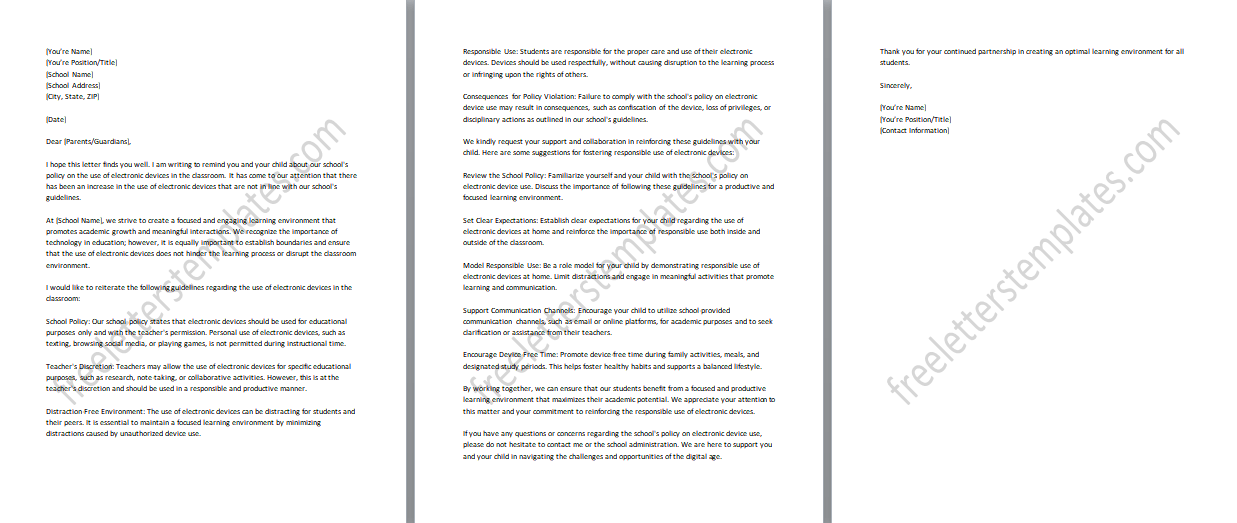
#16: Disrespect towards Peers:
A letter addressing incidents of disrespect or mistreatment of peers and promoting a positive and inclusive classroom environment.
Addressing incidents of disrespect or mistreatment towards peers requires a compassionate and proactive approach. When writing a letter, it’s important to express concern about these behaviors while emphasizing the importance of creating a positive and inclusive classroom environment. The goal is to engage parents or guardians in a collaborative conversation and seek their support in addressing the issue and promoting respectful behavior among students. By using a human-like tone, the letter can effectively communicate the impact of disrespect on peers and encourage parents or guardians to work together with the school in fostering a culture of empathy, understanding, and kindness among students.
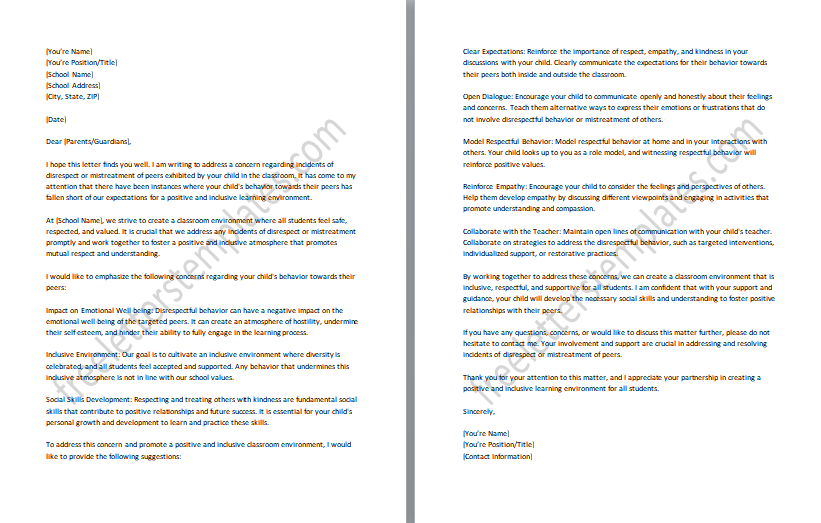
#17: Lack of Motivation:
A letter expressing concerns about a student’s lack of motivation or effort in their schoolwork and offering support and guidance.
Expressing concerns about a student’s lack of motivation or effort in their schoolwork requires a caring and supportive tone. When writing a letter, it’s important to address the issue while emphasizing the belief in the student’s potential and offering support and guidance to help them overcome their challenges. The goal is to engage parents or guardians in a collaborative conversation and encourage them to work together with the school to inspire and motivate the student. By using a human-like tone, the letter can effectively communicate the concern for the student’s academic progress and the commitment to helping them regain their motivation and find success in their schoolwork.
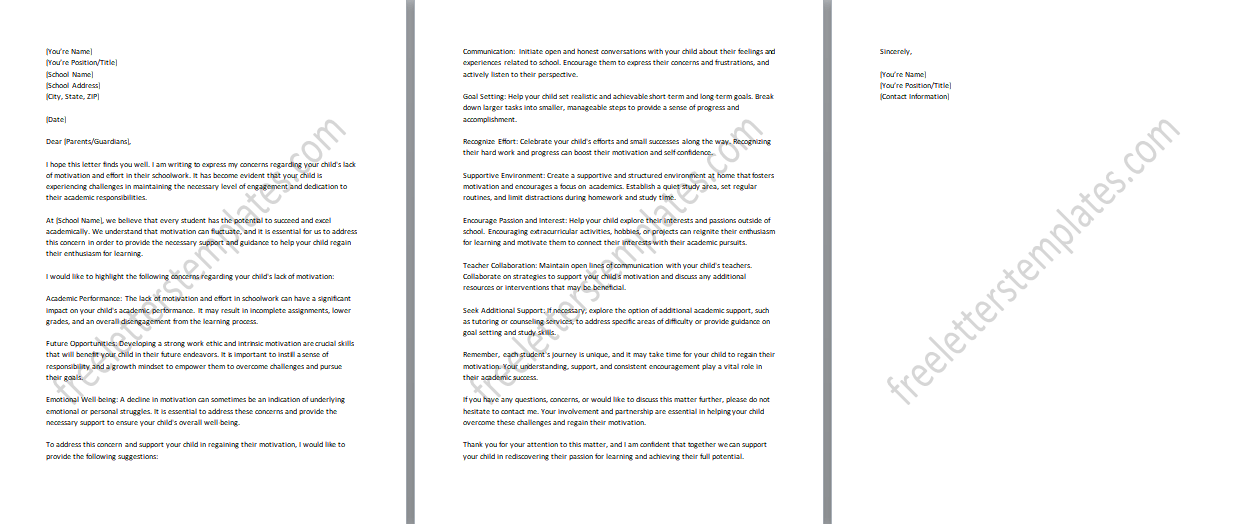
#18: Poor Test/Exam Performance:
A letter discussing a student’s consistently poor performance on tests or exams and suggesting strategies for improvement.
Addressing a student’s consistently poor performance on tests or exams requires a compassionate and supportive tone. When writing a letter, it’s important to express concern about the student’s struggles while offering encouragement and strategies for improvement. The goal is to engage parents or guardians in a collaborative conversation and reassure them that the school is dedicated to helping the student succeed. By using a human-like tone, the letter can effectively communicate empathy, understanding, and a commitment to working together to find solutions and support the student’s academic progress.
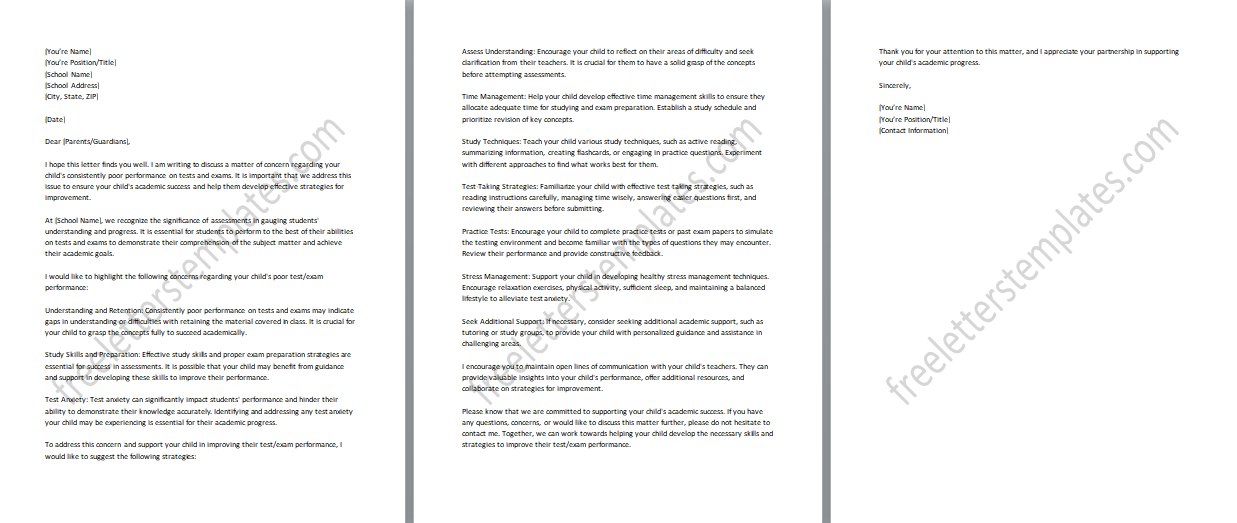
#19: Incomplete Assignments:
A letter notifying parents about a student’s frequent failure to complete assigned tasks and discussing the consequences of incomplete work. Addressing a student’s frequent failure to complete assigned tasks requires a clear and informative tone. When writing a letter, it’s important to notify parents or guardians about their child’s incomplete assignments and discuss the potential consequences of this behavior. The goal is to communicate the importance of completing assigned tasks and the impact they can have on the student’s academic progress. By using a human-like tone, the letter can effectively convey the school’s concern for the student’s academic success and engage parents or guardians in a collaborative effort to support the student in meeting their responsibilities and completing their assignments on time.
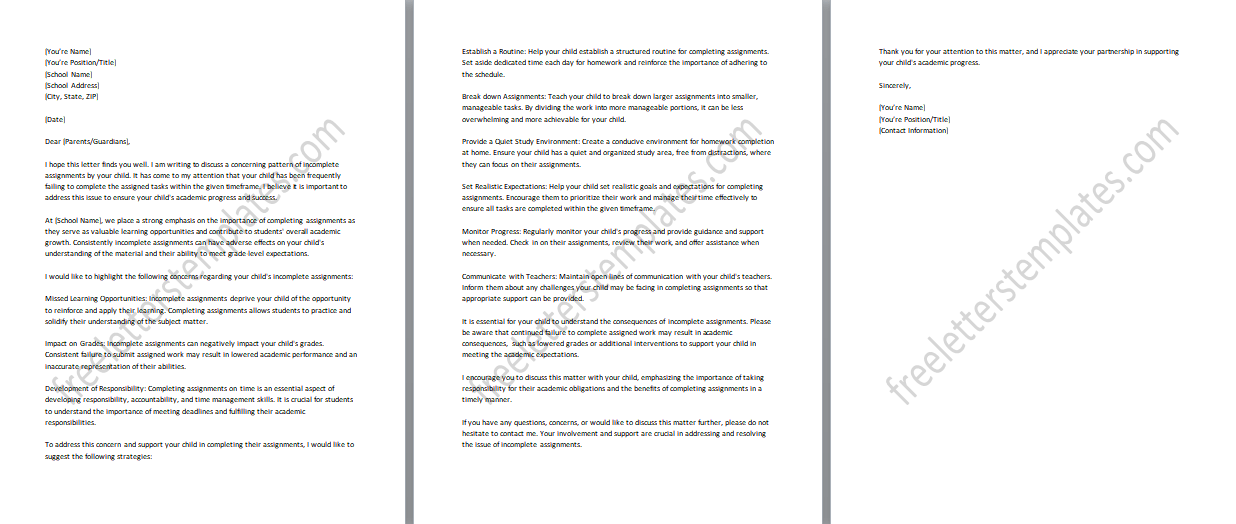
#20: Cheating or Academic Dishonesty:
A letter addressing instances of cheating or academic dishonesty and explaining the school’s policies and procedures regarding such behavior.
Addressing instances of cheating or academic dishonesty requires a serious and informative tone. When writing a letter, it’s important to explain to parents or guardians the school’s policies and procedures regarding such behavior, as well as the implications and consequences of cheating. The goal is to provide clear guidance on the expectations for academic integrity and emphasize the importance of honesty and ethical behavior in the learning environment. By using a human-like tone, the letter can effectively communicate the school’s commitment to maintaining a fair and supportive academic atmosphere while also seeking the collaboration of parents or guardians in addressing and preventing future instances of cheating or academic dishonesty.
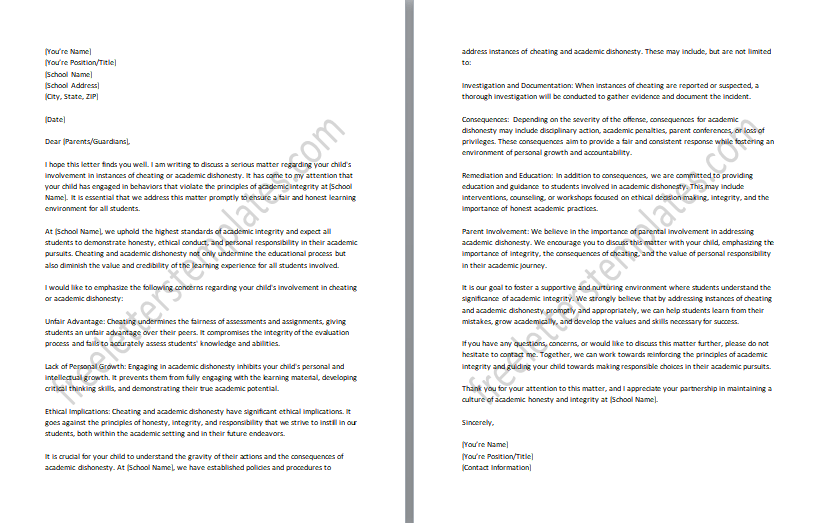
#21: Inappropriate Behavior during Special Events:
A letter discussing a student’s inappropriate behavior during school events, field trips, or assemblies.
Addressing a student’s inappropriate behavior during school events, field trips, or assemblies requires a firm but understanding tone. When writing a letter, it’s important to address the specific incidents of inappropriate behavior and discuss the impact it has on the overall experience for everyone involved. The goal is to communicate the expectations for appropriate behavior during special events and emphasize the importance of respect and cooperation. By using a human-like tone, the letter can effectively convey the school’s commitment to providing a safe and inclusive environment for all students and encourage parents or guardians to work together with the school to address and correct inappropriate behavior, ensuring future events are enjoyable for everyone.
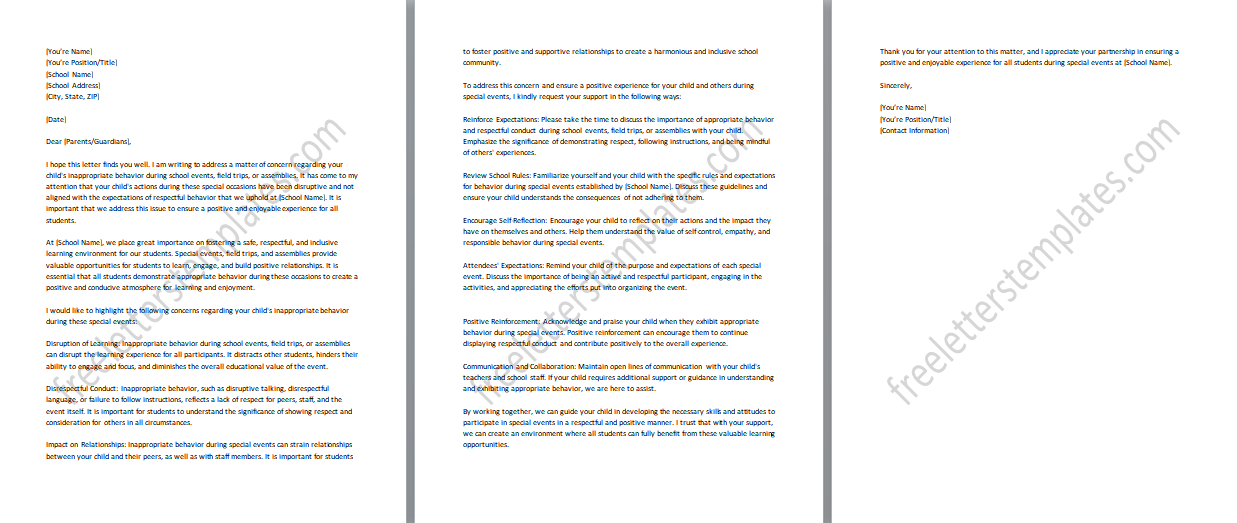
#22: Disrespect towards Authority:
A letter addressing incidents where a student has shown disrespect towards teachers or other school staff members.
Addressing incidents where a student has shown disrespect towards teachers or other school staff members requires a clear and authoritative tone. When writing a letter, it’s important to address the specific instances of disrespect and discuss the impact it has on the overall classroom environment and relationships between students and authority figures. The purpose of this letter is to address the inappropriate behavior, emphasize the importance of respect and positive communication, and outline the consequences if the behavior continues. By using a human-like tone, the letter can effectively communicate the school’s commitment to maintaining a respectful and supportive learning environment and encourage parents or guardians to work together with the school to address and correct the disrespectful behavior, ensuring a harmonious and productive educational experience for all students involved.
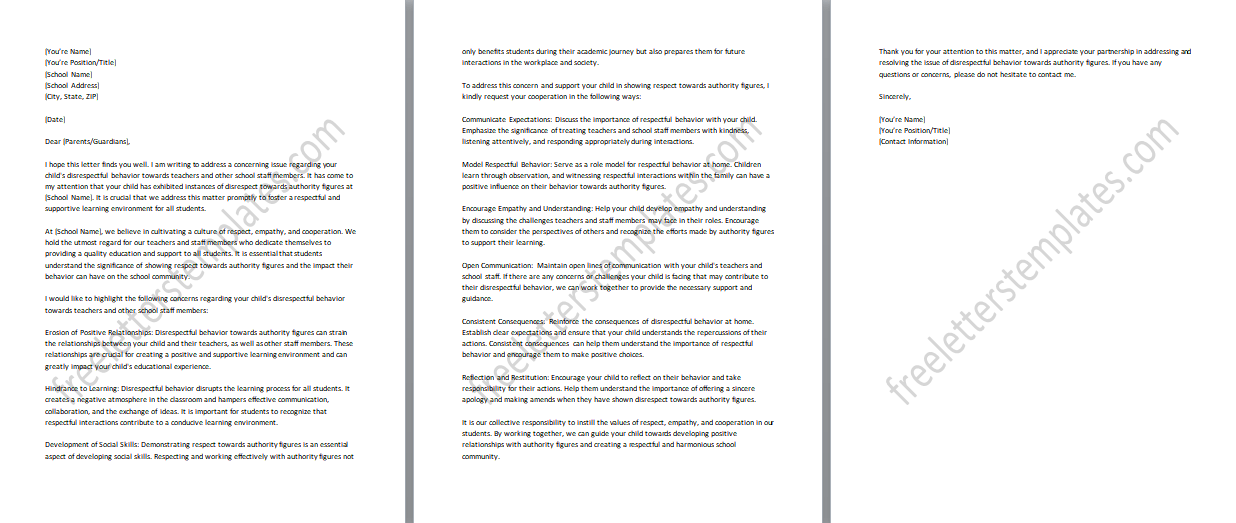
#23: Distracting Others:
A letter discussing a student’s behavior that consistently distracts or disrupts the learning environment for others.
Addressing a student’s behavior that consistently distracts or disrupts the learning environment for others requires a compassionate and empathetic tone. When discussing this issue in a letter, it’s important to acknowledge the concerns without placing blame or judgment on the student or their parents. The purpose of the letter is to express the teacher’s observations and concerns, highlight the importance of a focused and respectful learning environment, and invite collaboration with parents or guardians to address and resolve the issue. By using a human-like tone, the letter can effectively convey the teacher’s understanding and desire to work together with the student’s support system to create a positive and conducive learning atmosphere for everyone involved.
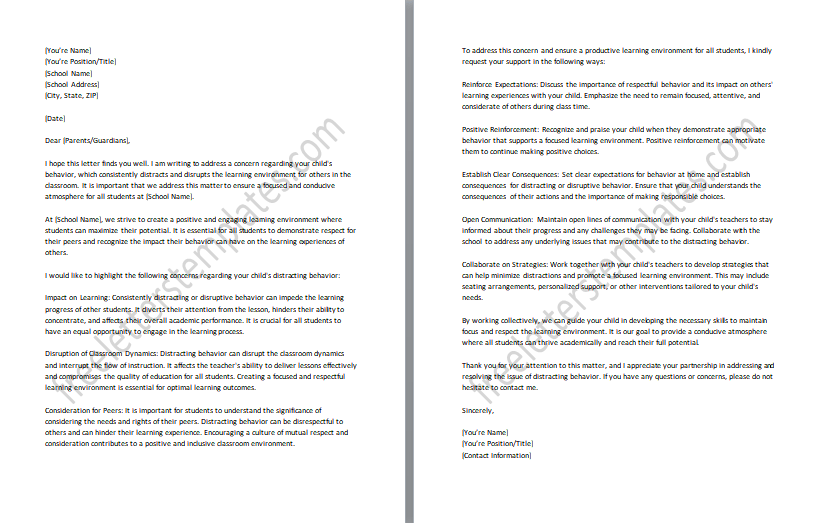
#24: Aggressive Behavior:
A letter addressing instances of physical aggression or violence by a student and outlining the disciplinary measures that will be taken.
Addressing instances of physical aggression or violence by a student requires a serious and empathetic approach. When writing a letter, it’s important to clearly communicate the gravity of the situation while maintaining a compassionate tone. The purpose of this letter is to address the specific incidents of aggressive behavior, express concern for the safety and well-being of all students, and outline the disciplinary measures that will be taken in accordance with school policies. The letter should also emphasize the importance of creating a safe and inclusive learning environment for all students and provide information on any additional support or interventions that will be implemented to address the underlying causes of the aggressive behavior. By using a human-like tone, the letter can effectively convey the school’s commitment to maintaining a secure learning environment and encouraging positive behavioral changes while reassuring parents or guardians that appropriate actions are being taken to ensure the well-being of all students involved.
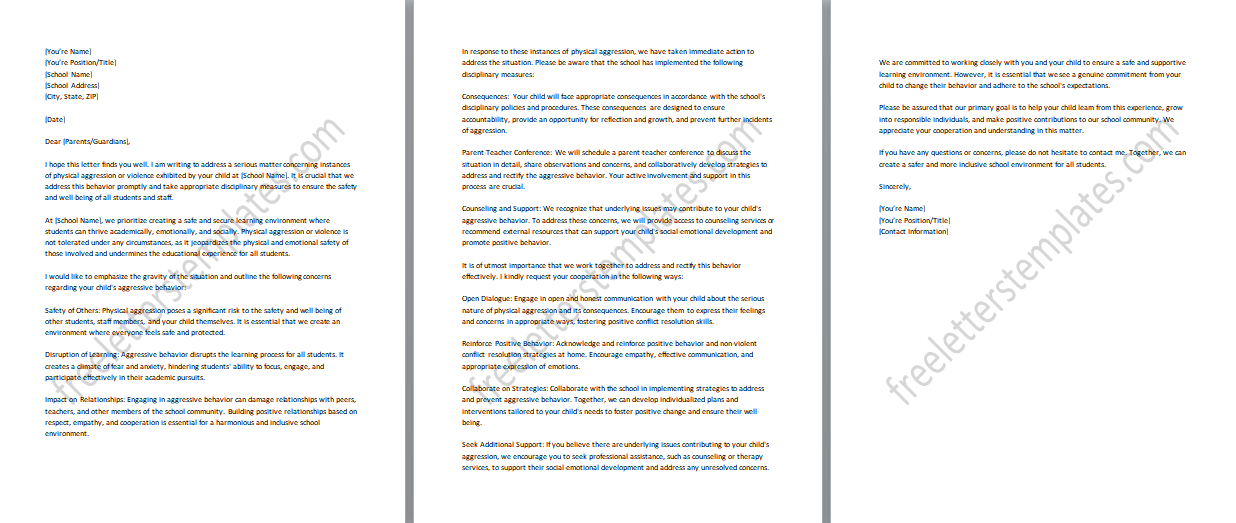
#25: Lack of Responsibility:
A letter highlighting a student’s lack of responsibility in completing assignments, bringing necessary materials, or following classroom procedures.
Addressing a student’s lack of responsibility in completing assignments, bringing necessary materials, or following classroom procedures requires a caring and empathetic approach. The purpose of this letter is to express the teacher’s concerns about the student’s current level of responsibility and to seek collaboration with parents or guardians in addressing the issue. It is important to convey a genuine desire to support the student’s growth and success while emphasizing the significance of taking responsibility for their actions and academic tasks. The tone should be warm, understanding, and focused on fostering a positive and supportive partnership between the teacher and the parents or guardians.
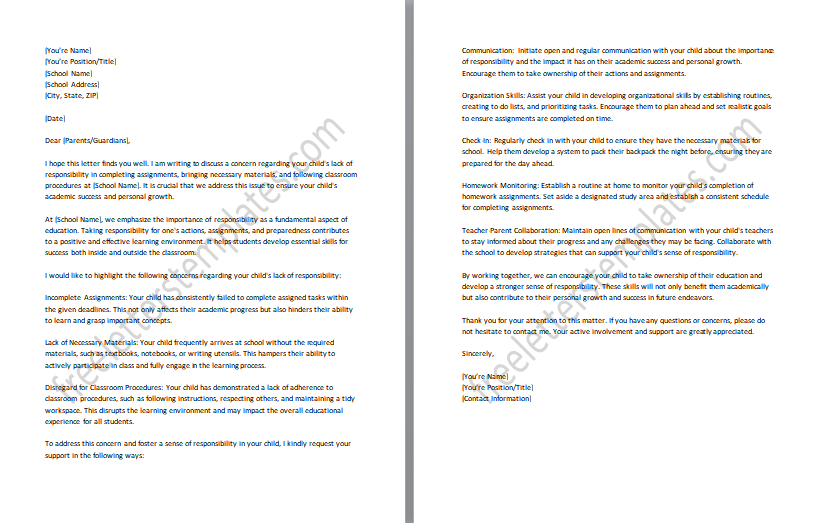
#26: Inattentiveness or Daydreaming:
A letter expressing concerns about a student’s frequent inattentiveness or daydreaming during class and suggesting strategies for improved focus.
Addressing a student’s frequent inattentiveness or daydreaming during class requires a caring and understanding approach. The purpose of this letter is to express the teacher’s concerns about the student’s difficulty in staying focused and to provide helpful strategies for improved attention and engagement. The goal is to support the student in maximizing their learning potential and creating a positive classroom experience. The tone of the letter should be warm, compassionate, and encouraging, emphasizing the teacher’s genuine interest in the student’s success. By offering practical tips and highlighting the importance of staying focused, the letter aims to assist the student in overcoming challenges and thriving academically.
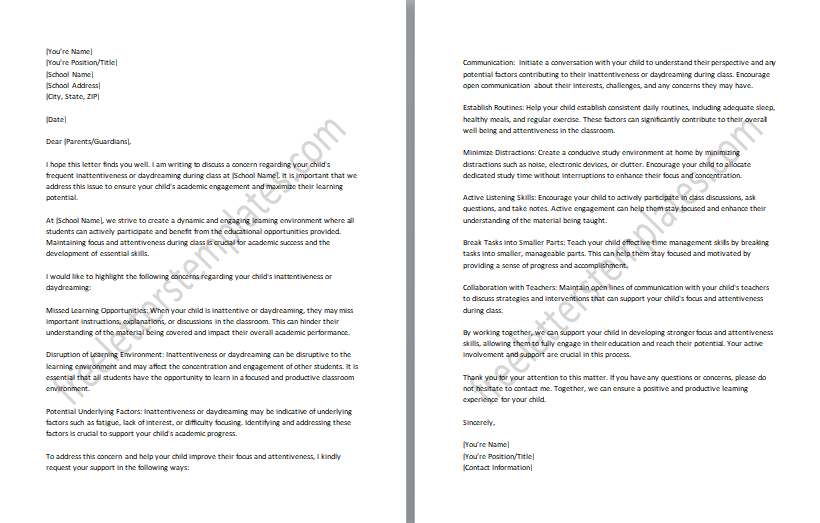
#27: Peer Pressure or Negative Influence:
A letter discussing concerns about a student’s involvement in negative peer pressure or being influenced by disruptive behavior.
Addressing concerns about a student’s involvement in negative peer pressure or being influenced by disruptive behavior requires a sensitive and supportive approach. The purpose of this letter is to express the teacher’s concerns about the student’s social interactions and potential exposure to harmful influences from peers. It aims to communicate the importance of positive relationships and decision-making while offering guidance and resources to help the student navigate these challenges. The tone of the letter should be caring, non-judgmental, and focused on the student’s well-being. By discussing the potential impact of negative peer pressure and providing strategies for resisting it, the letter seeks to empower the student to make healthy choices and build positive relationships. The ultimate goal is to foster a safe and inclusive learning environment where students can thrive both academically and socially.
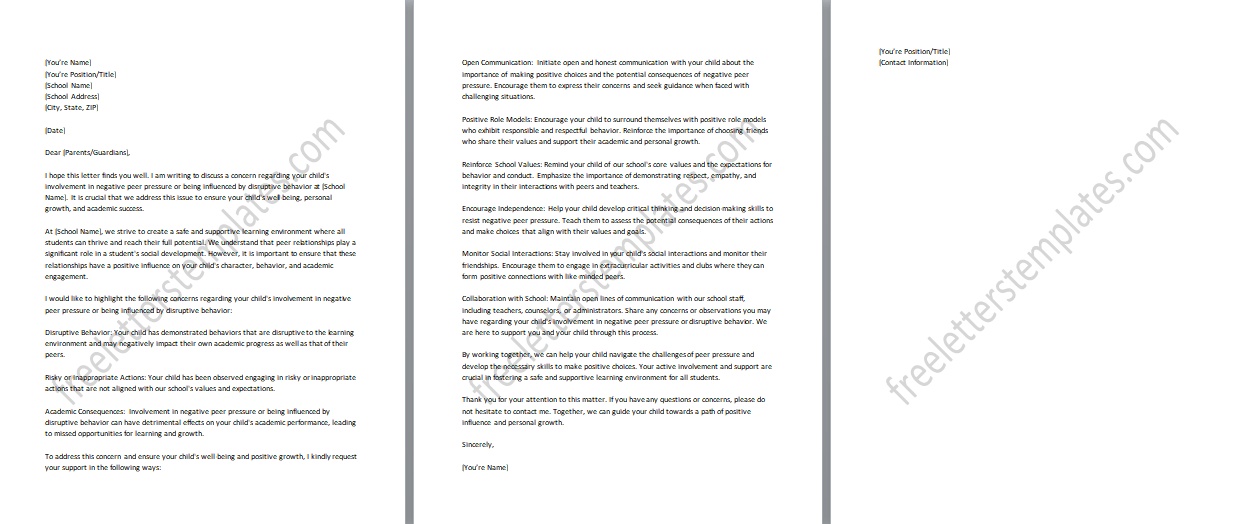
#28: Seeking Parental Support:
A letter seeking parental support and collaboration in addressing a student’s behavioral issues and establishing a consistent approach between home and school.
Addressing a student’s behavioral issues and promoting a consistent approach between home and school requires open communication and collaborative efforts. The purpose of this letter is to reach out to parents or guardians, seeking their support and partnership in addressing the student’s behavioral challenges. It aims to establish a strong home-school connection and emphasize the shared responsibility in shaping the student’s behavior. The tone of the letter should be welcoming, inclusive, and focused on fostering a positive learning environment for the student. By acknowledging the importance of parental involvement and suggesting ways to work together, the letter aims to create a unified approach that reinforces consistent expectations and strategies both at home and in the classroom. The ultimate goal is to provide the student with a supportive and consistent framework that promotes their personal growth and success.
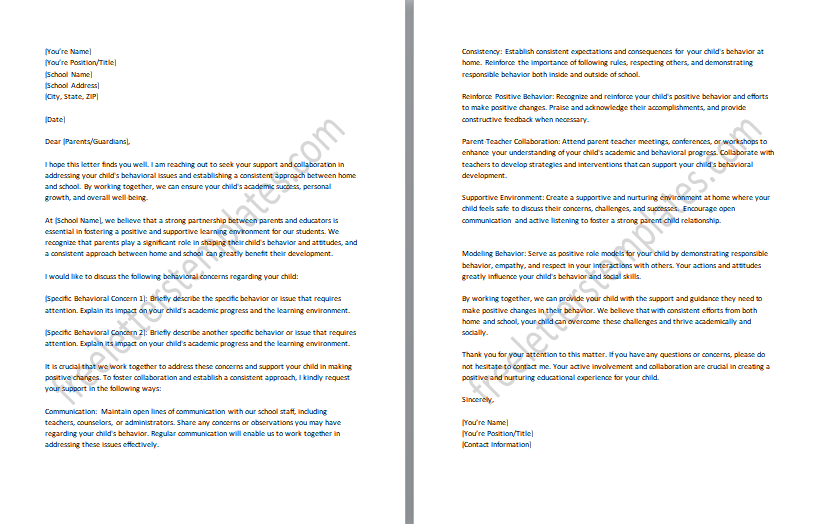
Empowering Parents in Addressing Student Behavior
In conclusion, we hope that our “Letter to Parents about Student’s Behavior in Classroom” templates have provided you with a valuable resource for effectively communicating with parents. Building a strong partnership between home and school is crucial in supporting your child’s growth and success. By utilizing these templates, we aim to empower you to address behavior-related matters with clarity, empathy, and understanding. Remember, open and constructive communication is key in addressing any challenges and fostering a positive learning environment for your child. We encourage you to customize these templates to fit your specific needs and maintain an ongoing dialogue with us. Together, we can create a nurturing and supportive environment that promotes your child’s academic, social, and emotional development. Thank you for your dedication and commitment to your child’s education.